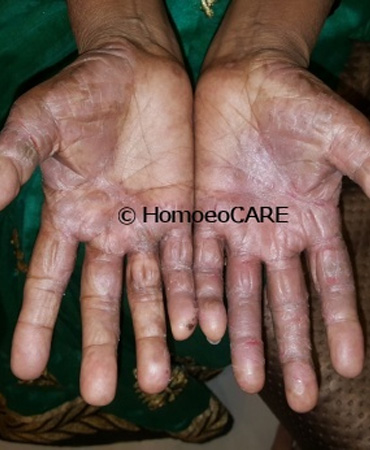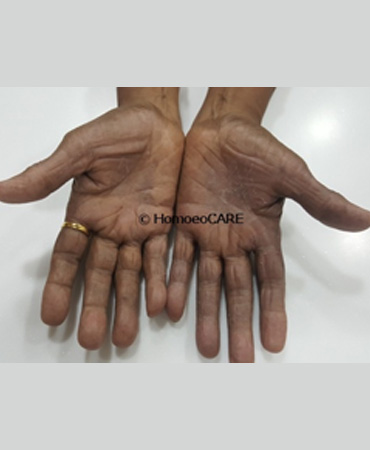Homeopathic Treatment for Palmoplantar Psoriasis: A Success Story
What is Palmoplantar Psoriasis?
Psoriasis is a chronic autoimmune skin condition in which the normal process of skin cell turnover is disrupted. Under normal circumstances, skin cells grow deep below the surface, then gradually rise to the top while shedding old cells. This cycle takes about a month. However, when the internal body stimulus is altered, skin cells multiply and rise too quickly, causing an accumulation of cells on the skin’s surface. This leads to flaking and patches of skin affected by psoriasis.
When psoriasis appears on the palms, it is known as palmar psoriasis. When it occurs on the soles, it is called plantar psoriasis. When both the palms and soles are affected, the condition is referred to as palmoplantar psoriasis. The key to homeopathic treatment for palmoplantar psoriasis is restoring the balance in the altered cell multiplication process.
Is Palmoplantar Psoriasis Curable?
While psoriasis is an autoimmune disorder, it is possible to manage and even reverse the altered cell multiplication process with homeopathic treatment. Homeopathic medicines have the ability to adjust the internal signals responsible for the rapid multiplication of skin cells. As a result, homeopathic treatment for palmar psoriasis, plantar psoriasis, or palmoplantar psoriasis can be highly successful in many cases.
Is Palmoplantar Psoriasis Contagious?
Psoriasis is caused by an autoimmune reaction, not an infection. It occurs when the internal signals governing cell multiplication are disturbed. Therefore, it is non-contagious. You cannot catch psoriasis from someone else, as it is not transmitted through direct contact.
Case Study: Successful Homeopathic Treatment of Palmoplantar Psoriasis
A 61-year-old female presented with complaints of itching, cracks, and peeling skin on both her soles and palms. She had been experiencing these symptoms for 6-7 years, and the condition was painful to the touch, making it difficult for her to hold anything in her hands. Her sleep was also disturbed due to intense itching.
After 8 weeks of homeopathic treatment, her skin showed significant improvement, with much less itching and fewer cracks. After another 8 weeks, while her skin remained dry, she could hold things again. Over the next 3 months, her skin continued to improve, with only slight symptoms remaining on her fingers and soles.
Conclusion
Homeopathic treatment for palmoplantar psoriasis focuses on correcting the underlying immune system disturbance that triggers abnormal cell multiplication. In the case of the 61-year-old woman, homeopathic remedies helped significantly improve her condition, offering relief from itching, pain, and skin cracks. This case illustrates how homeopathy can successfully manage and treat chronic skin conditions like palmoplantar psoriasis, bringing lasting improvements in skin health.



